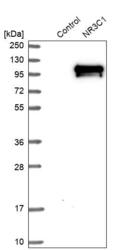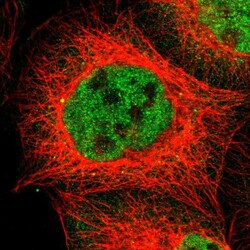Antibody data
- Antibody Data
- Antigen structure
- References [5]
- Comments [0]
- Validations
- Western blot [1]
- Immunocytochemistry [1]
Submit
Validation data
Reference
Comment
Report error
- Product number
- HPA004248 - Provider product page

- Provider
- Atlas Antibodies
- Proper citation
- Atlas Antibodies Cat#HPA004248, RRID:AB_1078976
- Product name
- Anti-NR3C1
- Antibody type
- Polyclonal
- Description
- Polyclonal Antibody against Human NR3C1, Gene description: nuclear receptor subfamily 3, group C, member 1 (glucocorticoid receptor), Alternative Gene Names: GR, GRL, Validated applications: ICC, WB, Uniprot ID: P04150, Storage: Store at +4°C for short term storage. Long time storage is recommended at -20°C.
- Reactivity
- Human
- Host
- Rabbit
- Conjugate
- Unconjugated
- Isotype
- IgG
- Vial size
- 100 µl
- Concentration
- 0.1 mg/ml
- Storage
- Store at +4°C for short term storage. Long time storage is recommended at -20°C.
- Handling
- The antibody solution should be gently mixed before use.
Submitted references The Glucocorticoid Receptor NR3C1 in Testicular Peritubular Cells is Developmentally Regulated and Linked to the Smooth Muscle-Like Cellular Phenotype
Hypoxia regulates GR function through multiple mechanisms involving microRNAs 103 and 107
Limitations to intergenerational inheritance: subchronic paternal stress preconception does not influence offspring anxiety
Chronic stress and intestinal barrier dysfunction: Glucocorticoid receptor and transcription repressor HES1 regulate tight junction protein Claudin-1 promoter
Glucocorticoids Have Opposing Effects on Liver Fibrosis in Hepatic Stellate and Immune Cells
Welter H, Herrmann C, Dellweg N, Missel A, Thanisch C, Urbanski H, Köhn F, Schwarzer J, Müller-Taubenberger A, Mayerhofer A
Journal of Clinical Medicine 2020;9(4):961
Journal of Clinical Medicine 2020;9(4):961
Hypoxia regulates GR function through multiple mechanisms involving microRNAs 103 and 107
Yang N, Berry A, Sauer C, Baxter M, Donaldson I, Forbes K, Donn R, Matthews L, Ray D
Molecular and Cellular Endocrinology 2020;518
Molecular and Cellular Endocrinology 2020;518
Limitations to intergenerational inheritance: subchronic paternal stress preconception does not influence offspring anxiety
Fennell K, Busby R, Li S, Bodden C, Stanger S, Nixon B, Short A, Hannan A, Pang T
Scientific Reports 2020;10(1)
Scientific Reports 2020;10(1)
Chronic stress and intestinal barrier dysfunction: Glucocorticoid receptor and transcription repressor HES1 regulate tight junction protein Claudin-1 promoter
Zheng G, Victor Fon G, Meixner W, Creekmore A, Zong Y, K. Dame M, Colacino J, Dedhia P, Hong S, Wiley J
Scientific Reports 2017;7(1)
Scientific Reports 2017;7(1)
Glucocorticoids Have Opposing Effects on Liver Fibrosis in Hepatic Stellate and Immune Cells
Kim K, Lee J, Zhou Y, Harpavat S, Moore D
Molecular Endocrinology 2016;30(8):905-916
Molecular Endocrinology 2016;30(8):905-916
No comments: Submit comment
Enhanced validation
- Submitted by
- Atlas Antibodies (provider)
- Enhanced method
- Recombinant expression validation
- Main image

- Experimental details
- Western blot analysis in control (vector only transfected HEK293T lysate) and NR3C1 over-expression lysate (Co-expressed with a C-terminal myc-DDK tag (~3.1 kDa) in mammalian HEK293T cells, LY424874).
- Sample type
- Human
- Protocol
- Protocol
Supportive validation
- Submitted by
- Atlas Antibodies (provider)
- Main image

- Experimental details
- Immunofluorescent staining of human cell line A-431 shows localization to nucleoplasm & cytosol.
- Sample type
- Human
 Explore
Explore Validate
Validate Learn
Learn Western blot
Western blot Immunocytochemistry
Immunocytochemistry